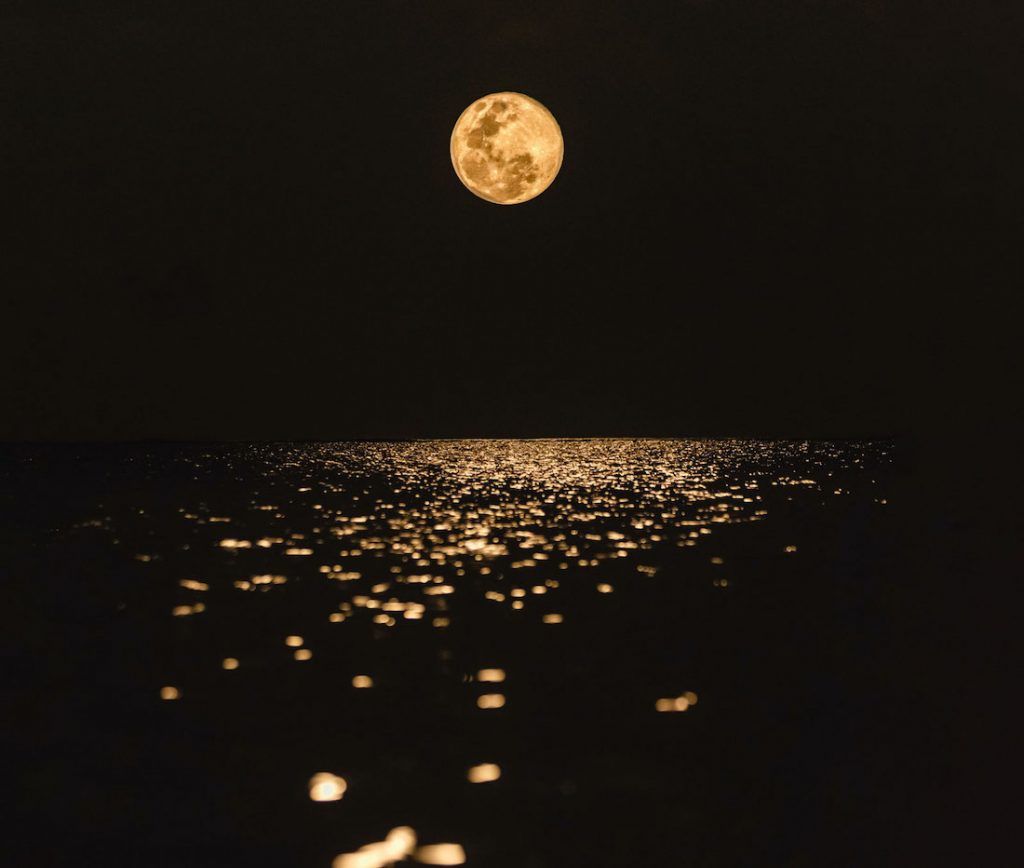A friend and I were walking on the beach just before sunset one day. We walked leisurely and talked little, our words pulled from the air with the same slowness with which our feet moved through the shallow water. It was the kind of afternoon that calls for silence. Above us, the clouds were huge, backlit with that soft glow that signals the day’s end, and at one point we stopped and stared, and my friend remarked that the sky was like a painting. I agreed, and as we were turning to leave, a strange shape over the horizon caught my eye. “What is that?” I asked, pointing at what appeared to be a large triangle hovering over the ocean, rusty red and out of place in all that blue. A moment later, as the low-hanging clouds parted, we realized we were looking at a piece of the moon—illumination at 100 percent, a moon chart later said. Like a child transfixed, I plopped down on the sand right where I was and stared with my mouth agape as a blood-red moon slowly climbed up the sky, leaving a reddish wake on the water.
Syzygy (SIZ-eh-jee) is the alignment of two or more celestial bodies in a straight or near-straight line. An imperfect alignment results in the new and full moons, for example; a perfect one in an eclipse. The term comes from the Greek syzygein, which means “to yoke together.” In addition to astronomy, the concept is also used in biology, mathematics, philosophy, and psychology to refer to the union between two things. Figuratively, a yoke has connotations of subservience: a yoke is a heavy, oppressive burden. But in yoga—the Sanskrit term for “yoke”—this union is between a practitioner and the divine. Likewise, in Buddhism, there’s a metaphor that presents us with a far richer way of thinking about this alignment: Indra’s Diamond Net.
In the Avatamsaka Sutra or Flower Ornament Sutra—a collection of texts compiled beginning around 500 years after the Buddha’s death until about 300 CE—the universe is described as a vast net on whose every node hangs a glittering diamond. On the polished surface of this diamond, every other diamond is reflected, multiplying the reflection into infinity. Each diamond exists both in its own right and is also connected to every other diamond on the net. Just so, each one of us is unique, and connected to every other being and thing in the universe—which means we’re constantly affecting one another in ways known and unknown.
I never suffer or celebrate by myself, because nothing I do or say or even think exists apart from anything else.
In the seventies, the mathematician and meteorologist Edward Norton Lorenz discovered what he termed the “butterfly effect.” Using a weather model, he showed that even minor environmental fluctuations—like the flapping of a butterfly’s wing in Brazil—could set off large and distant weather events, such as a tornado in Texas. Through this experiment, Lorenz was simply confirming what Buddhism has known for millennia. When I touch a strand of the net in my little corner of the world, the whole web trembles. This kind of knowledge confers responsibility, of course, but it also offers great comfort. The image of Indra’s Net is meant to liberate us. It’s meant to free us from the illusion that we’re singular, separate, and solitary. And the fact that we’re thoroughly interconnected means that neither my sadness nor my joy, neither my biggest failing nor my most resounding success is mine alone. I never suffer or celebrate by myself, because nothing I do or say or even think exists apart from anything else. What a relief! What an effective balm for our endemic loneliness.
When I lived at Zen Mountain Monastery, I loved sitting on rainy afternoons during sesshin, our monthly silent meditation retreat. The mountain seemed especially alive then, and when I felt my energy flagging, I imagined drawing strength and life directly from the woods, the rushing rain, the two streams that converged just beyond the monastery gate and flowed into the Hudson and eventually the Atlantic. The practice never failed. I could start a period of zazen feeling utterly depleted, and after drawing to me the light from all the diamonds surrounding me, I’d gradually become infused with energy.
This yoke is not oppressive but liberating. It’s not burden but ballast. What’s singular is isolated and therefore infinitely fragile. A legion’s strength, on the other hand, is in numbers. Indra’s net reminds us that we’re always aligned—however imperfectly—and always together. When we’re flailing, this is a truth from which we can draw strength.
These are the places where I take refuge these days. A walk on the beach. The space between words. Under a painted sky and a rising moon, swollen with light and impossible to ignore. A sparkling net stretched tautly over reality, its diamond light reflecting endlessly.
I hope you find refuge too, either in places of your own devising or wherever you’re surprised into remembering that you’re not alone, you’re not forsaken. Everything is here, and it all holds you, perfectly.
Thank you for subscribing to Tricycle! As a nonprofit, we depend on readers like you to keep Buddhist teachings and practices widely available.
